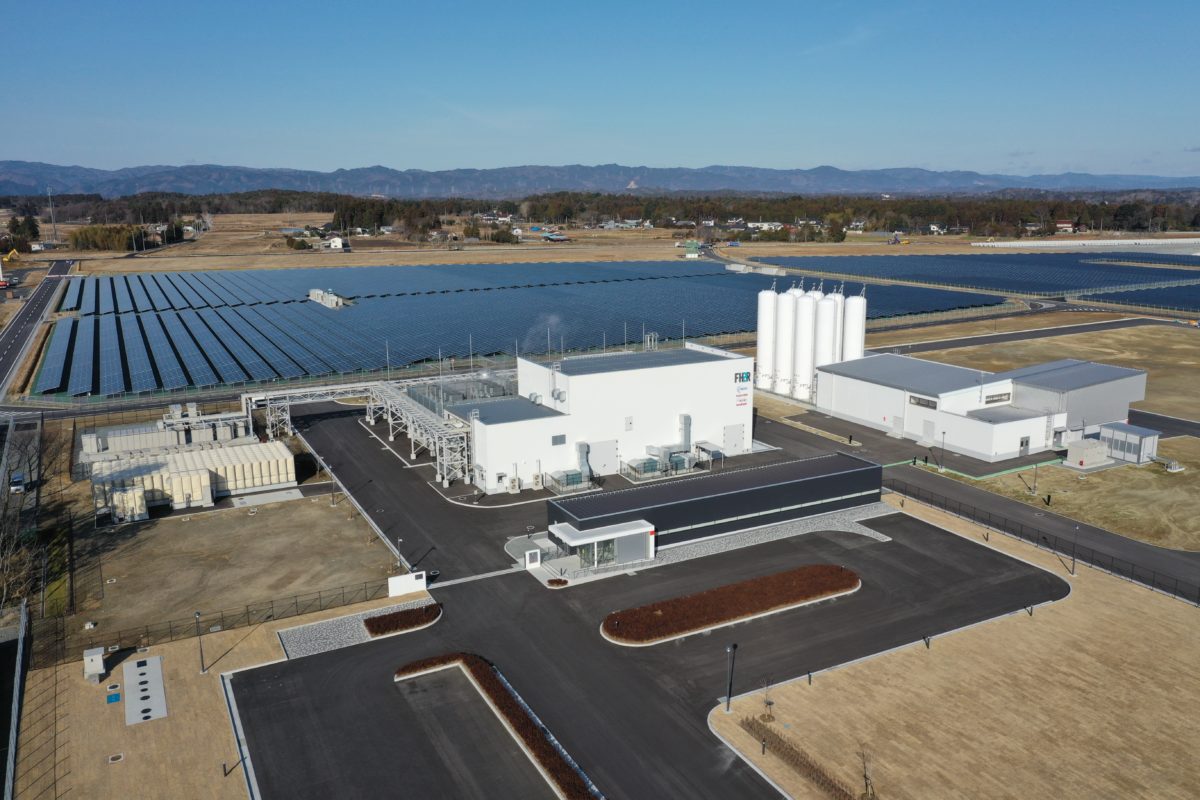Japanese conglomerate Toshiba Corporation has announced its Fukushima Hydrogen Energy Research Field (FH2R) project, on which construction began in July 2018, is operational.
The solar-powered 10 MW hydrogen plant in Namie town, Fukushima prefecture, is said to be able to produce 1,200 normal cubic meters (Nm3) of hydrogen per hour.
The intermittent nature of solar generation prompted Toshiba to design the facility to be able to adjust to supply and demand in the grid, the company said.
“Hydrogen produced at FH2R will also be used to power stationary hydrogen fuel cell systems and to provide for … mobility devices, fuel-cell cars and buses and more,” Toshiba added. “The most important challenge in the current stage of testing is to use the hydrogen energy management system to achieve the optimal combination of production and storage of hydrogen and power grid supply-demand balancing adjustments without the use of storage batteries.”
Solar power
The plant is being powered by 20 MW of solar generation capacity as well as grid power. The hydrogen generated is being transported in trailers and hydrogen bundles to users elsewhere in the prefecture as well as the Tokyo metropolitan area and other regions.
In early January, Toshiba commissioned the H2One Station Unit, an energy storage system producing hydrogen at the Toyama City Environment Center in Toyama prefecture. According to the company, that kind of installation can be deployed easily and operated by customers such as factories, harbors, airports and bus depots. A similar facility was deployed at the end of December in Tsuruga City, in the Hokuriku region.
Toshiba’s energy system and solutions business began a demonstration of an holistic hydrogen supply chain for electricity generation in May 2018.
The multinational had announced in February 2016 it would place more emphasis on its energy and storage businesses following an accounting scandal which had prompted a restructure and losses of around $6 billion in 2015.
This article was amended on 10/03/20 to reflect the claimed hourly hydrogen production capacity is measured in normal cubic meters rather than newton meters, as previously reported.
This content is protected by copyright and may not be reused. If you want to cooperate with us and would like to reuse some of our content, please contact: editors@pv-magazine.com.




It’s 1200 Normal Cubic Meters (meaning 1200 m³ at standard temperature and pressure), not 1200 cubic Newton-meters.
Thank you Marcel (and Dom and Jon) for pointing out my editing error. I translated the Nm3 figure quoted by Toshiba as newton meters, which is a measure of torque, rather than normal cubic meters, which is the correct volume measurement. I shall be sitting on the naughty step for the remainder of the day.
The units for expressing hydrogen flow should be Normal metres cubed per hour, not cubic Newton metres which is a measure of mechanical torque.
Just a small note.
Nm³ is a common notation for “Normal Cubic Meters”, that is a cubic meter at standard temperature and pressure. It’s used as a measurement of gas volume.
It’s not “cubic newton meters” as mentioned in the article. It’s possible the author saw “cubic Nm” and misunderstood.
(Nm or Newton meters is a unit of force and makes little sense in this context, cubed or not.)
If these numbers are correct, the energy output is 12,75 [MJ/m3] x 1200 [m3] / 3600 [s] = 4 MW for an energy input of 10 MW, i.e. a 25% efficiency. This is hardly competitive.
It doesn’t matter. If the solar array wasn’t there the input energy would go to waste, heating the ground. I presume that during periods of high demand the electricity will go straight to the grid and only used to generate H2 when there is slack. A similar form of operation could be used with wind-farms, hydro and nuclear. The stored H2 becomes a “battery” that can be used to generate electricity when the sun doesn’t shine and the wind doesn’t blow.